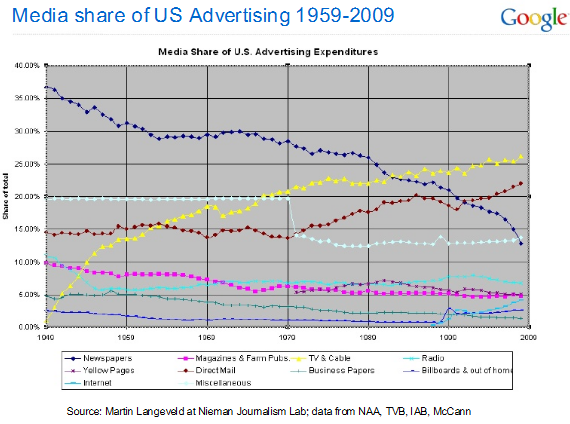Some thoughts on The Times and their paywall as relayed to a journalist recently, though in a slightly expanded and modified form.
Isn’t it sad that it’s 2010 and only now are papers doing something in this always-on multimedia world to up their game? Now we are told we’ll get some quality content after all the years of decline in quality and readership. Something is needed to bring back quality, maybe it’ll be the idea of paywalls that will bring it back and then maybe a different model to retain quality will happen. This recent presentation from Hal Varian from Google actually shows newspaper revenues have been under attack since the 50s.

Google has never been a threat. Terrible content has been. Looking at the media these days, you can’t tell which news site you’re on as every story is the same. Far too many pieces are just copied and pasted from press releases, especially the breaking news sections of sites.
It’s been a race to the bottom for years with newspapers cutting back on journalists and editors, relying too much on using news feeds that all other papers use and taking less and less risks to break stories. No longer have newspapers been setting the news agenda but covering it with a slight timeshift.
Paywalls won’t work if you are hiding the bland content that is also on so many other websites out there. The internet has been designed to route around “damage” or blockages so if you are blocking your content that’s based on a press release, it will be available elsewhere.
Initial reports from the Times are that there are “value adds” behind the paywall. More images, more insight, access to journalists etc. This is value and it is unique and I think people will pay for that.
Instead of charging for this content, other alternatives would be to sell historic data, to give free access to the main site but analysis type reports which can be used to enrich a company would be sold. Imagine having the Irish Times create a report on the state of technology in Ireland and opinions from their most experienced journalists on what are areas to punt on? Charge a few hundred euros for the report. Same for all the other industries they cover and tie it in with pass historical records from their archives.
There’s also way more money to be made from advertising if they made it more targeted and more automated. Instead of charging for banner impressions which makes both sides lazy, they should be working with advertisers on a cost per conversion model. Get direct custom from a newspaper site, pay more.
There are also sorts of additional streams too like business conferences, sport events with their pundits and the sports stars they know. Bands make less from album sales and more from touring these days apparently, a working business model, why not the same for newspapers? Too much hard work. I watched a documentary about UK dockers and in particular the Liverpool ones who resisted the cargo boxes for years and the shipping world passed them by. The print model worked for a while but it’s very odd that it really has not changed in decades despite all the warning signs being there.
Hey Damien,
I gave a talk on similar topic at Bizcamp the other week, and you have encouraged me to put it up online here:
http://www.yaboya.com/2010/06/creating-experiences-online-that-people-will-pay-for/
In order for media companies to create new business models, they must re-assess who exactly their customer is and what the problems are that they are solving. Traditionally, they have relied on the advertising model, an easy to comprehend system where targeted audiences (product) are sold to advertisers (customer).
Now, to build other revenue streams, they must go back to the drawing board to identify a real problem that people are experiencing and then solve it for them. I suggest that they leverage their reach, brand and resources in order to do this and build from the bottom up a new batch of customers who are willing to pay for the services that they have created.
One glaring thing to note is that there is a big difference between an audience and a customer.
Anyway, good post! Enjoyed reading it.
It’s not just the recycled press releases, it’s the identical syndicated content from the likes of AP, UPI, etc. When newspapers and radio stations in a country as small as Ireland think that they can take that and run with it locally too, you know you’re in trouble.
On the subject of historical access, NY Times did that and it doesn’t seem to have worked, given that they eventually took the paywall down. That said, your spin on it could work. I always said that that would be a perfect way for the Phoenix to get online and make good money out of it.
Finally, on cost per conversion, it sounds ideal but very granular reporting needs to be available, and major, major trust. I don’t take commission based advertising on Foot.ie because I don’t trust the betting companies that try to sell it to me. Would you? 😉
adam
You hit the nail on the head pointing out that people will pay for extra value, which seems to be a point that all these papers are missing.
It’s the same mentality that all these collapsing industries seem to have – they think in terms of what price they feel their product is worth, not what they think people are willing to pay.
As soon as you start converting a portion of your readers into paying customers with “value add” then life becomes much more fun for papers – give away great quality news articles for free, attract readers, offer added value to convert a % into paying customers, repeat.
(p.s. my own 2c on the topic, if you’re interested http://petertanham.com/2009/11/murdochs-paywall)